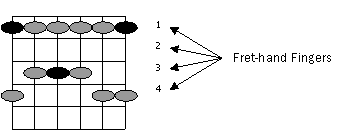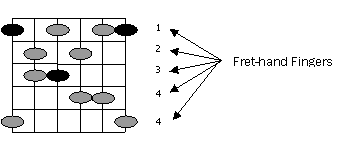When guitar players first start to improvise, they usually create their own guitar solos with the major and minor pentatonic scales.
This great at first, but unfortunately, over time it can start to get pretty darn boring.
In fact, it’s quite common for guitar players to get stuck in a pentatonic rut. All your guitar solos start to sound the same.
The good news is there are many ways to break out of this pentatonic rut.
One such way is to use some different pentatonic scales for some much-needed variety. You can intersperse other pentatonic scales as tiny phrases, or you can use them more extensively.
Today our focus is on an advanced topic. We will look at a hybrid or altered pentatonic scale.
When most guitarists think of pentatonic scales they tend to only think of the very popular minor pentatonic and major pentatonic scales. There is however a vast array of pentatonic scales beyond the basic major and minor pentatonic scales.
Our focus will be on a somewhat outside but nonetheless cool-sounding hybrid/altered pentatonic scale.
Now there is no real name for this scale. It is not a standard pentatonic scale. A pentatonic scale is simply a five-note scale. The pentatonic scale we will examine today can be thought of as also being a Dominant 7 #11 arpeggio.
Here is how it is constructed:
1 3 #4/#11 5 b7
So as you can see, it is a Dominant 7 #11 (1-3-5-b7-#11).
This scale has a very cool sound and can be used in a wide variety of contexts. Do understand that the #4/#11 can create some tension depending on the context it is used in.
But actually, I’m getting a bit ahead of myself here. Right now, I’m sure you want to see how you can play this scale. So let’s first compare it to the regular minor pentatonic scale fingering…
Minor Pentatonic Scale (1─b3─4─5─b7)
Hybrid Pentatonic (1─3─#4─5─b7)
In terms of the fingering, only two notes have been changed when you compare this scale to the minor pentatonic scale. Both the third and fourth are raised by one semitone. The b3 goes to a natural 3, and 4 goes to a #4.
Now I’m not going to go into all of the theory and mechanics behind this scale today. What we will briefly look at is some of the chords you can use this scale with.
First of all, this hybrid pentatonic scale will work over a power chord. Position the above scale so that the root notes (black notes in the diagram) are on the note A. This will put your first finger on the fifth fret. If you play this scale, on the fifth fret, the notes in it will be: A C# D# E G. This scale can be played over an A power chord. The A power chord, or A5 chord contains the notes A and E. As you can see, both of these notes are contained within this scale.
This scale will also work over an A major chord, A7, A9, A7 #11 and A9 #11. It will also work with A13, and A13 #11.
For an outside bluesy type sound, you can actually use this scale against an A minor chord. Depending on context, this will create some pretty strong tension so you will probably want to resolve it to the regular minor pentatonic scale.
This short tutorial just scratched the surface of the many possible uses for this scale.
Practice the scale forwards and backwards until you’ve got it memorized, then apply some melodic patterns to it. This will help you to “hear” the scale and will start to give you some ideas of ways to use it.
Also experiment with playing the minor pentatonic scale ascending and then this hybrid pent scale descending and vice versa. Also experiment with using this scale with the major pentatonic scale, the blues scale and the composite blues scales.
This will give you lots to work on. Have fun with it. For more information on pentatonic scales, hybrid and altered pentatonic scales you’ll probably be interested in my book called The World of Scales: A Compendium of Scales for the Modern Guitar Player.











